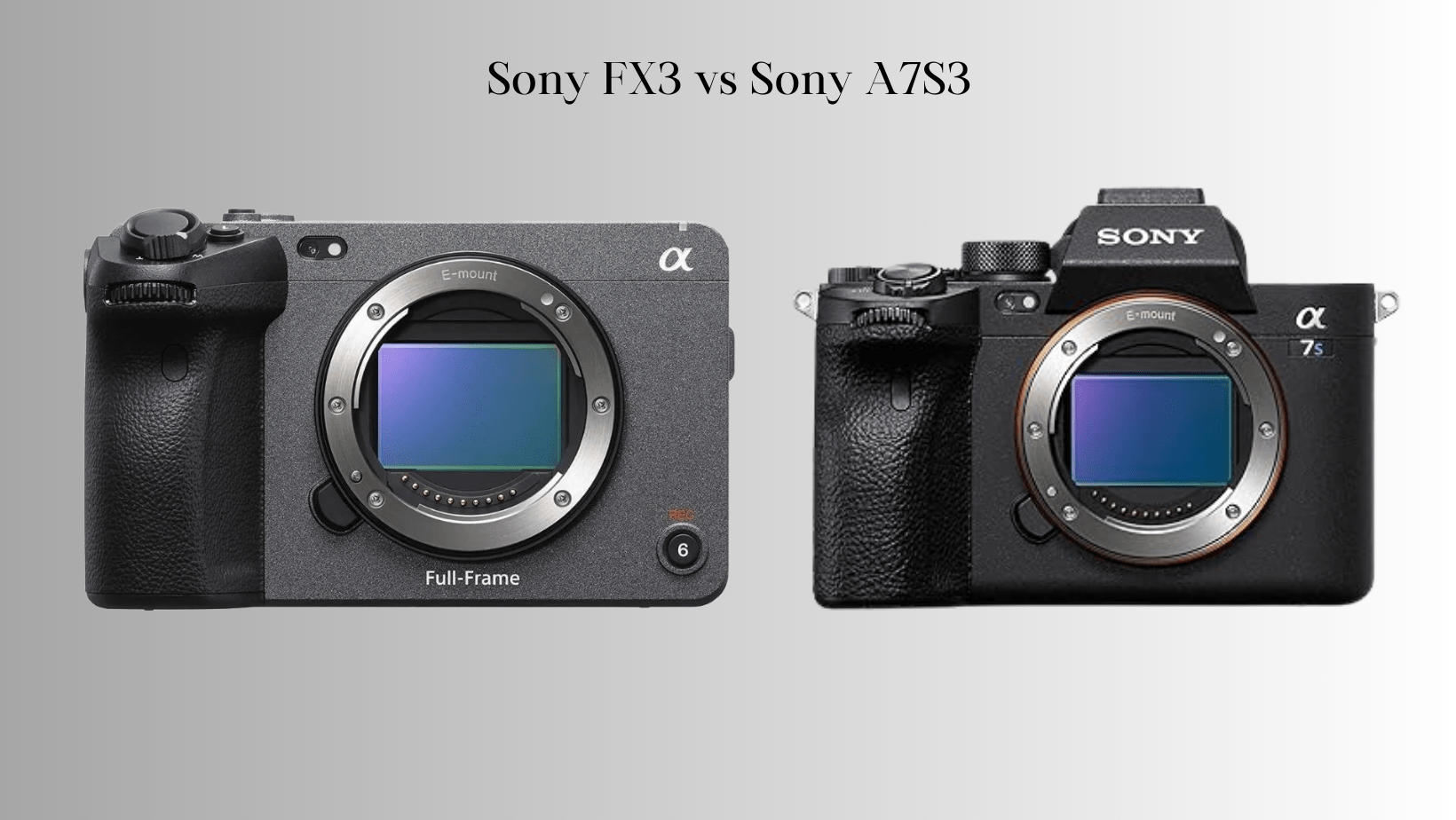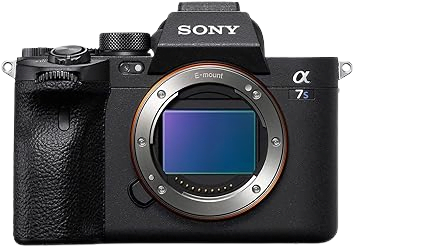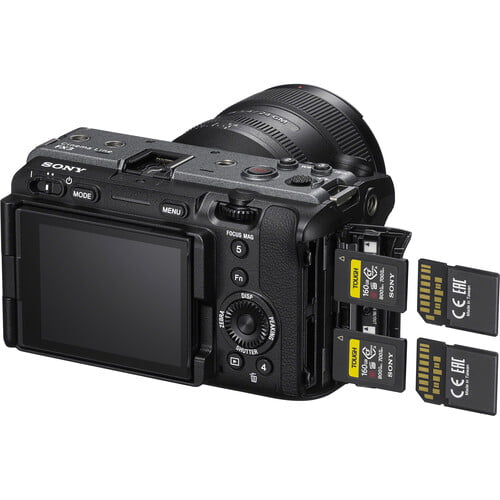
Sony FX3 Vs Sony A7S3 | Which one to choose for your next project?
Choosing gear for your project is not easy and when it comes to cinematography there is a lot of confusion about whether you should go for Sony A7siii or Sony FX3.
In this comprehensive analysis, we will compare the Sony FX3 and the Sony A7S III, both of which are professional mirrorless cameras. The Sony FX3 made its debut in February 2021, while the Sony A7S III was released in July 2020. With only a seven-month gap between the two models, we anticipate that this comparison will provide a fair assessment, taking into account their relative age and technological advancements.
1. Form Factor and Design:
- Sony FX3:
- The FX3 is designed with a compact and ergonomic form factor, resembling a traditional camcorder. It features a top handle with dedicated controls for ease of use in handheld shooting scenarios. The compact design is well-suited for solo operators or those working in tight spaces.
- Fan for active cooling for longer shooting times
- Button layout optimized for video
- Multiple tally lights on front and back

- Sony A7S III:
- The A7S III follows the design principles of Sony’s Alpha series mirrorless cameras. It has a more familiar camera form factor with a built-in electronic viewfinder and a tilting touchscreen. The design is geared towards versatility, catering to both photographers and videographers.
- Requires cage/rig for mounting accessories
- Optional XLR Adapter needed for advanced audio
- No active cooling, overheating potential

Sony FX3 is clearly a winner in this category!
2. Sensor and Resolution:
- Sony FX3:
- The FX3 sports a 12.1-megapixel full-frame sensor. The lower resolution is a deliberate choice to enhance low-light performance and provide larger pixels for improved sensitivity.
- Sony A7S III:
- The A7S III features a 12.1-megapixel full-frame sensor, also optimized for low-light conditions. The slightly higher resolution may be advantageous for photographers looking to capture still images with more detail.
3. ISO Performance:
- Sony FX3:
- With an extended ISO range of up to 409,600, the FX3 excels in low-light shooting conditions, making it ideal for professional video production in challenging environments.
- Sony A7S III:
- Similar to the FX3, the A7S III boasts an impressive ISO range, providing excellent low-light performance for both video and still photography.
4. Video Capabilities:
- Sony FX3:
- The FX3 is designed primarily as a cinema camera, supporting 4K video recording up to 120fps. It offers 10-bit 4:2:2 internal recording and includes the S-Cinetone color profile, providing a cinematic look out of the box.
- Sony A7S III:
- The A7S III is known for its exceptional video capabilities, offering 4K recording up to 120fps. It supports 10-bit 4:2:2 internal recording, and its extensive range of picture profiles, including S-Log2 and S-Log3, caters to professional filmmakers.
5. Autofocus:
- Sony FX3:
- The FX3 features Fast Hybrid AF with 627 phase-detection points and 89% coverage, providing reliable autofocus for video and stills. However, it may not match the advanced Real-time Eye AF found in the A7S III.
- Sony A7S III:
- The A7S III incorporates an advanced autofocus system with 759 phase-detection points and Real-time Eye AF for both humans and animals. This makes it an excellent choice for solo shooters or those capturing dynamic scenes with moving subjects.
6. In-Body Image Stabilization (IBIS):
- Sony FX3:
- The FX3 does not have in-body image stabilization. Stability relies on lens stabilization or external stabilization solutions.
- Sony A7S III:
- The A7S III features 5-axis in-body image stabilization (IBIS), providing enhanced stability for handheld shooting. This is beneficial for both video and still photography, especially when using lenses without built-in stabilization.
7. Audio Inputs:
- Sony FX3:
- The FX3 includes two XLR/TRS combo jacks for professional audio input. This is advantageous for users who require high-quality audio recording in their video production.

- The FX3 includes two XLR/TRS combo jacks for professional audio input. This is advantageous for users who require high-quality audio recording in their video production.
- Sony A7S III:
- The A7S III has a standard 3.5mm microphone input and a headphone jack. While it supports external microphones, it does not have built-in XLR inputs like the FX3.
8. Built-in ND Filters:
- Sony FX3:
- One standout feature of the FX3 is the built-in electronic variable ND filter. This allows for seamless and precise control of exposure without adjusting aperture or shutter speed.
- Sony A7S III:
- The A7S III does not have a built-in ND filter. Users need to rely on external ND filters to control exposure in bright conditions.
9. Build and Durability:
- Sony FX3:
- The FX3 is constructed with a durable magnesium alloy body, providing robustness and effective heat dissipation during prolonged shooting.
- Sony A7S III:
- The A7S III also features a robust build with weather-sealing for protection against dust and moisture. It is well-suited for various shooting conditions.
10. Storage:
- Sony FX3:
- The FX3 uses CFexpress Type A and SD UHS-II memory cards for storage.

- The FX3 uses CFexpress Type A and SD UHS-II memory cards for storage.
- Sony A7S III:
- The A7S III supports dual card slots for CFexpress Type A and SD UHS-II memory cards, providing redundancy and flexibility in storage options.
Conclusion:
The choice between the Sony FX3 and Sony A7S III depends on the specific needs and preferences of the user. The FX3 is tailored for professional video production, offering a compact cinema camera design with features like built-in ND filters and XLR inputs. On the other hand, the A7S III provides a more versatile solution, excelling in both video and still photography with advanced autofocus, in-body image stabilization, and extensive video capabilities. Users should consider their primary use case, whether it be dedicated filmmaking or a combination of photo and video work, to make an informed decision. Always check for the latest updates and user reviews for the most current information.





